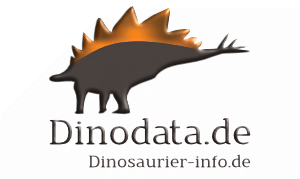FAMILIENLISTE / Ankylosauria

Osborn, 1923
Ornithischia Thyreophora Ankylosauria
Bei den Ankylosauria ("gebogene Echsen") handelt es sich um vierbeinige (quadrupede), massiv gebaute Pflanzenfresser. Die Ankylosauria werden in zwei Untertaxa geteilt, die Ankylosauridae und die Nodosauridae. Der große Unterschied zwischen den Taxa ist, dass die meisten Ankylosaurier knöcherne Keulen am Ende ihrer Schwänze besaßen, die bei den Nodosauriern fehlten.
Alle Ankylosauria besaßen auf der Oberseite und an den Flanken ihres Körpers knöcherne Platten, sogenannte Osteoderme. Diese setzten sich aus mehreren Hundert einzelner Platten zusammen, welche in die Haut eingelagert waren. Dies ermöglichte den Tieren daher trotz der starken Panzerung große Bewegungsfreiheit. Auch besaßen einige Arten wie der Nodosaurier Sauropelta Stacheln oder auch Dornen im Bereich der Schulter oder den Hüften. Die Schädel der Ankylosauria waren massiv, der Hals war kurz und dick. Auf der Oberseite des Schädels und bei einigen Arten auch an den Wangen waren wulstige Knochenauswüchse vorhanden. P. Martin Sander und Torsten Scheyer stellten bei einer Untersuchung fossilen Materials fest, dass in den Knochenplatten Kollagenfasern eingearbeitet waren, die eine ineinander verwobene, dreidimensionale Struktur bildeten. Damit erreichte die Panzerung eine enorme Stabilität bei vergleichsweise geringem Gewicht.
Ankylosaurier waren niedrig gebaut, ihr Schädel befand sich meist nicht mehr als 1 Meter über dem Boden. Sie besaßen kleine, dreieckige Zähne, die lose angeordnet waren, ähnlich wie bei den Stegosauriern. Die großen Zungenbeinknochen zeigen an, dass sie wahrscheinlich lange, flexible Zungen besaßen. Sie hatten außerdem einen großen, seitlichen sekundären Gaumen. Dies bedeutet, dass sie anders als zum Beispiel Krokodile, beim Kauen atmen konnten. Ihr Darm war vermutlich erweitert und besaß die Fähigkeit zur Gärung, um die Nahrung mit Hilfe symbiotischer Bakterien in der Darmflora leichter zu verdauen. Ihre Nahrung bestand aus wahrscheinlich aus Farnen, Palmfarnen und Angiospermen. Jordan Mallon et al. untersuchten im Jahr 2013 das Zusammenleben von Pflanzenfressern auf dem Inselkontinent Laramidia während der späten Kreidezeit. Sie stellten fest, dass Ankylosaurier in der Regel Vegetation fraßen, die unterhalb der Höhe von 1 Meter zu finden war.
Die ersten Ankylosaurier erschienen in der frühen Jura und sie lebten bis zum Ende der Kreidezeit. Fossilien dieser Tiere wurden bis heute auf allen Kontinenten entdeckt außer in Afrika. Die traditionellen Ankylosaurier lebten in der Kreidezeit, sie hatten viel größere Körper und eine dickere Panzerung, sogar die Augenlider waren mit Knochenplatten geschützt. Der bekannteste Vertreter seiner Art ist sicher der dieser Familie den Namen gebende Ankylosaurus. Die großen schweren Keulen am Ende ihrer Schwänze bestanden aus zusammengewachsenen Knochen und dienten wahrscheinlich der Selbstverteidigung vor Raubtieren. Die Ankylosauria ernährten sich wahrscheinlich von niedrig wachsenden Farnen und Kräutern. Ihr breites Maul lässt vermuten, dass sie nicht auf bestimmte Pflanzenformen spezialisiert waren.
 Thyreophora
Thyreophora
 Ankylosauria
Ankylosauria
. Dracopelta
. Liaoningosaurus
. Sarcolestes
. Scolosaurus
. Sinankylosaurus
. Spicomellus
- Ankylosauridae
Ankylosauridae
-. Aletopelta
-. Bissektipelta
-. Cedarpelta
-. Horshamosaurus
-. Chuanqilong
-. Gobisaurus
-. Minmi
-. Minotaurasaurus
-. Pinacosaurus
-. Shamosaurus
-. Tatankacephalus
-. Tianchisaurus
-. Ziapelta
-- Ankylosaurinae
Ankylosaurinae
--. Ahshislepelta
--. Ankylosaurus (Typ)
--. Anodontosaurus
--. Crichtonsaurus
--. Datai
--. Dyoplosaurus
--. Euoplocephalus
--. Jinyunpelta
--. Nodocephalosaurus
--. Oohkotokia
--. Platypelta
--. Saichania
--. Tarchia
--. Talarurus
--. Tsagantegia
--. Zaraapelta
--.
Platypelta
--- Ankylosaurini
Ankylosaurini
---. Akainacephalus
---. Scolosaurus
---. Zuul
---- Parankylosauria
Parankylosauria
----. Antarctopelta
----. Kunbarrasaurus
----. Stegouros

Ankylosauriers
© Victoria Arbour

© Victoria Arbour
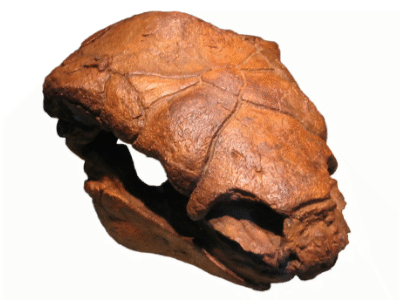
Ankylosaurus
© Brian Smith
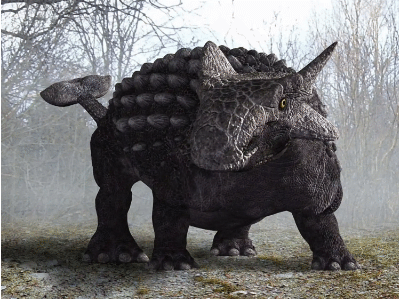
© Raul Lunia
---
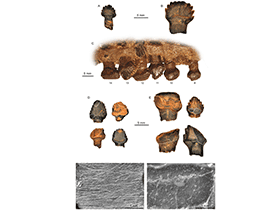
Ankylosaurier-Zähne
© Mallon & Anderson
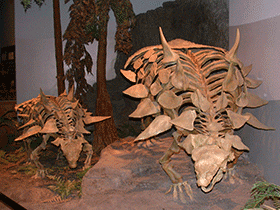
Gastonia
© Steve Lew
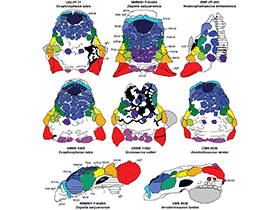
Ankylosauriern
© Arbour et al.
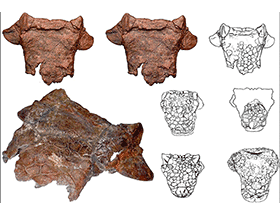
Oohkotokia
© Paul Penkalski
Weitere Informationen
A new ankylosaurid from the Upper Cretaceous Nemegt Formation of Mongolia and implications for paleoecology of armoured dinosaurs / Jin-Young Park, Yuong-Nam Lee, Yoshitsugu Kobayashi, Louis L. Jacobs, Rinchen Barsbold, Hang-Jae Lee, Namsoo Kim, Kyo-Young Song, Michael J. Polcyn, 2021 / Scientific Reports volume 11, Article number: 22928 /
/ Jin-Young Park, Yuong-Nam Lee, Yoshitsugu Kobayashi, Louis L. Jacobs, Rinchen Barsbold, Hang-Jae Lee, Namsoo Kim, Kyo-Young Song, Michael J. Polcyn, 2021 / Scientific Reports volume 11, Article number: 22928 /  PDF
PDF
A new ankylosaurid skeleton from the Upper Cretaceous Baruungoyot Formation of Mongolia: its implications for ankylosaurid postcranial evolution / Jin-Young Park, Yuong-Nam Lee, Philip J. Currie, Michael J. Ryan, Phil Bell, Robin Sissons, Eva B. Koppelhus, Rinchen Barsbold, Sungjin Lee, Su-Hwan Kim, 2021 / Scientific Reports volume 11, Article number: 4101 (2021)
/ Jin-Young Park, Yuong-Nam Lee, Philip J. Currie, Michael J. Ryan, Phil Bell, Robin Sissons, Eva B. Koppelhus, Rinchen Barsbold, Sungjin Lee, Su-Hwan Kim, 2021 / Scientific Reports volume 11, Article number: 4101 (2021) PDF
PDF
A new ankylosaurine dinosaur from the Judith River Formation of Montana, USA, based on an exceptional skeleton with soft tissue preservation  / Victoria M. Arbour, David C. Evans, 2017 / The Royal Society Vol. 4, Nr. 5 /
/ Victoria M. Arbour, David C. Evans, 2017 / The Royal Society Vol. 4, Nr. 5 / PDF
PDF
A new armored dinosaur with double cheek horns from the early Late Cretaceous of southeastern China / Lida Xing, Kecheng Niu, Jordan C. Mallon, Tetsuto Miyashita, 2024 / Vertebrate Anatomy Morphology Palaeontology 11:113–132 /
/ Lida Xing, Kecheng Niu, Jordan C. Mallon, Tetsuto Miyashita, 2024 / Vertebrate Anatomy Morphology Palaeontology 11:113–132 / PDF
PDF
An ankylosaurid dinosaur from the Upper Cretaceous of Shandong (China) / Eric Buffetaut, 1995 / Geological Magazine, Volume 132, Issue 6, November 1995, pp. 683-692
An ankylosaur larynx provides insights for bird-like vocalization in non-avian dinosaurs ![]() / Junki Yoshida, Yoshitsugu Kobayashi, Mark A. Norell, 2023 / Communications Biology volume 6, Article number: 152. https://doi.org/10.1038/s42003-023-04513-x /
/ Junki Yoshida, Yoshitsugu Kobayashi, Mark A. Norell, 2023 / Communications Biology volume 6, Article number: 152. https://doi.org/10.1038/s42003-023-04513-x / PDF
PDF
Analyzing Taphonomic Deformation of Ankylosaur Skulls Using Retrodeformation and Finite Element Analysis / Victoria M. Arbour, Philip J. Currie, 2012 / PLoS ONE 7(6): e39323. doi:10.1371/journal.pone.0039323 /
/ Victoria M. Arbour, Philip J. Currie, 2012 / PLoS ONE 7(6): e39323. doi:10.1371/journal.pone.0039323 / PDF
PDF
Ankylosauridae (Dinosauria) from Mongolia / Teresa Maryańska, 1977 / Palaeontologia Polonica 37; 85 - 151
/ Teresa Maryańska, 1977 / Palaeontologia Polonica 37; 85 - 151
Ankylosaur Remains from the Early Cretaceous (Valanginian) of Northwestern Germany / Sven Sachs, Jahn J. Hornung, 2013 / PLoS ONE 8(4): e60571. doi:10.1371/journal.pone.0060571 /
/ Sven Sachs, Jahn J. Hornung, 2013 / PLoS ONE 8(4): e60571. doi:10.1371/journal.pone.0060571 / PDF
PDF
A New Ankylosaurid Dinosaur from the Upper Cretaceous (Kirtlandian) of New Mexico with Implications for Ankylosaurid Diversity in the Upper Cretaceous of Western North America / Victoria M. Arbour, Michael E. Burns, Robert M. Sullivan, Spencer G. Lucas, Amanda K. Cantrell, Joshua Fry, Thomas L. Suazo, 2014 / PLoS ONE 9(9): e108804. doi:10.1371/journal.pone.0108804 /
/ Victoria M. Arbour, Michael E. Burns, Robert M. Sullivan, Spencer G. Lucas, Amanda K. Cantrell, Joshua Fry, Thomas L. Suazo, 2014 / PLoS ONE 9(9): e108804. doi:10.1371/journal.pone.0108804 /![]() PDF
PDF
A new ankylosaurid from the late Cretaceous Two Medicine Formation of Montana, USA / Paul Penkalski, 2014 / Acta Palaeontologica Polonica 59 (3), 2014: 617-634. doi: dx.doi.org/10.4202/app.2012.0125 /
/ Paul Penkalski, 2014 / Acta Palaeontologica Polonica 59 (3), 2014: 617-634. doi: dx.doi.org/10.4202/app.2012.0125 / PDF
PDF
A New Basal Ankylosaurid (Dinosauria: Ornithischia) from the Lower Cretaceous Jiufotang Formation of Liaoning Province, China  / Fenglu Han, Wenjie Zheng, Dongyu Hu, Xing Xu, Paul M. Barrett, 2014 / PLoS ONE 9(8): e104551. doi:10.1371/journal.pone.0104551 /
/ Fenglu Han, Wenjie Zheng, Dongyu Hu, Xing Xu, Paul M. Barrett, 2014 / PLoS ONE 9(8): e104551. doi:10.1371/journal.pone.0104551 / PDF
PDF
A new southern Laramidian ankylosaurid, Akainacephalus johnsoni gen. et sp. nov., from the upper Campanian Kaiparowits Formation of southern Utah, USA /
Jelle P. Wiersma, Randall B. Irmis, 2018 / PeerJ 6:e5016 / https://doi.org/10.7717/peerj.5016 /
/
Jelle P. Wiersma, Randall B. Irmis, 2018 / PeerJ 6:e5016 / https://doi.org/10.7717/peerj.5016 / PDF
PDF
A new specimen of Pinacosaurus grangeri (Dinosauria, Ornithischia) from the late Cretaceous of Mongolia : ontogeny and phylogeny of ankylosaurs / Robert V. Hill, Lawrence M. Witmer, Mark A. Norell, 2003 / American Museum novitates; no. 3395
A polacanthine ankylosaur (Ornithischia: Dinosauria) from the Early Cretaceous (Barremian) of eastern Utah /
Spencer G. Lucas, James I. Kirkland, John W. Estep, 1998 / New Mexico Museum of Natural History and Science Bulletin Nr. 14
/
Spencer G. Lucas, James I. Kirkland, John W. Estep, 1998 / New Mexico Museum of Natural History and Science Bulletin Nr. 14
An ankylosaur (ornithischian dinosaur) from the Middle Jurassic of the Junggar Basin, China / Dong Zhiming, 1993 / Vertebrata Palasiatica 31, pp. 258 - 264
/ Dong Zhiming, 1993 / Vertebrata Palasiatica 31, pp. 258 - 264
An ankylosaurian dinosaur from the Cenomanian Dunvegan Formation of northeastern British Columbia, Canada
Victoria M. Arbour, Derek Larson, Matthew Vavrek, Lisa Buckley, David Evans, 2020 / Fossil Record, 23, 179–189, https://doi.org/10.5194/fr-23-179-2020 / PDF
PDF
An ankylosaurid dinosaur from Mongolia with in situ armour and keratinous scale impressions / Victoria M. Arbour, Nicolai L. Lech-Hernes, Tom E. Guldberg, Jørn H. Hurum, Philip J. Currie, 2013 / Acta Palaeontologica Polonica 58 (1), 2013: 55-64 doi: dx.doi.org/10.4202/app.2011.0081 / PDF
PDF
An ankylosaurid (Ornithischia: Ankylosauria) braincase from the Upper Cretaceous Bissekty Formation of Uzbekistan / Alexander O. Averianov, 2002 / Buletin de l'Institut Royal des Sciences. Naturelles de Belgique, Sciences de la Terre 72:97-110, 2002
Ankylosaur systematics: example using Panoplosaurus and Edmontonia (Ankylosauria: Nodosauridae) / Kenneth Carpenter, 1991 / Cambridge University Press. DOI: 10.1017/CBO9780511608377.024
Bizarre tail weaponry in a transitional ankylosaur from subantarctic Chile / Sergio Soto-Acuña, Alexander O. Vargas, Jonatan Kaluza, Marcelo A. Leppe, Joao F. Botelho, José Palma-Liberona, Carolina Simon-Gutstein, Roy A. Fernández, Héctor Ortiz, Verónica Milla, Bárbara Aravena, Leslie M.E. Manríquez, Jhonatan Alarcón-Muñoz, Juan Pablo Pino, Christine Trevisan, Héctor Mansilla, Luis Felipe Hinojosa, Vicente Muñoz-Walther, David Rubilar-Rogers, 2021 / Research Square, DOI: 10.21203/rs.3.rs-821192/v1 /
/ Sergio Soto-Acuña, Alexander O. Vargas, Jonatan Kaluza, Marcelo A. Leppe, Joao F. Botelho, José Palma-Liberona, Carolina Simon-Gutstein, Roy A. Fernández, Héctor Ortiz, Verónica Milla, Bárbara Aravena, Leslie M.E. Manríquez, Jhonatan Alarcón-Muñoz, Juan Pablo Pino, Christine Trevisan, Héctor Mansilla, Luis Felipe Hinojosa, Vicente Muñoz-Walther, David Rubilar-Rogers, 2021 / Research Square, DOI: 10.21203/rs.3.rs-821192/v1 / PDF
PDF
Cranial osteology of the ankylosaurian dinosaur formerly known as Minmi sp. (Ornithischia: Thyreophora) from the Lower Cretaceous Allaru Mudstone of Richmond, Queensland, Australia / Lucy G. Leahey, Ralph E. Molnar, Kenneth Carpenter, Lawrence M. Witmer, Steven W. Salisbury, 2015 / PeerJ 3:e1475; DOI 10.7717/peerj.1475 /
/ Lucy G. Leahey, Ralph E. Molnar, Kenneth Carpenter, Lawrence M. Witmer, Steven W. Salisbury, 2015 / PeerJ 3:e1475; DOI 10.7717/peerj.1475 / PDF
PDF
Dental microwear of a basal ankylosaurine dinosaur, Jinyunpelta and its implication on evolution of chewing mechanism in ankylosaurs / Tai Kubo, Wenjie Zheng, Mugino O. Kubo, Xingsheng Jin, 2021 / PLoS ONE 16(3): e0247969. https://doi.org/10.1371/journal.pone.0247969
/ Tai Kubo, Wenjie Zheng, Mugino O. Kubo, Xingsheng Jin, 2021 / PLoS ONE 16(3): e0247969. https://doi.org/10.1371/journal.pone.0247969  PDF
PDF
Euoplocephalus tutus and the Diversity of Ankylosaurid Dinosaurs in the Late Cretaceous of Alberta, Canada, and Montana, USA / Victoria M. Arbour, Philip J. Currie, 2013 / PLoS ONE 8(5): e62421. doi:10.1371/journal.pone.0062421 /
/ Victoria M. Arbour, Philip J. Currie, 2013 / PLoS ONE 8(5): e62421. doi:10.1371/journal.pone.0062421 / PDF
PDF
Estimating Impact Forces of Tail Club Strikes by Ankylosaurid Dinosaurs / Victoria Megan Arbour, 2009 / PLoS ONE 4(8): e6738. doi:10.1371/journal.pone.0006738 /
/ Victoria Megan Arbour, 2009 / PLoS ONE 4(8): e6738. doi:10.1371/journal.pone.0006738 / PDF
PDF
Evidence for a Sauropod-Like Metacarpal Configuration in Ankylosaurian Dinosaurs / Phil Senter, 2011 / Acta Palaeontologica Polonica 56(1):221-224. 2011 / doi: http://dx.doi.org/10.4202/app.2010.0041 /
/ Phil Senter, 2011 / Acta Palaeontologica Polonica 56(1):221-224. 2011 / doi: http://dx.doi.org/10.4202/app.2010.0041 /![]() PDF
PDF
Hands, feet and behaviour in Pinacosaurus (Dinosauria: Ankylosauridae) / Philip J. Currie, Demchig Badamgarav, Eva B. Koppelhus, Robin Sissons, Matthew K. Vickaryous, 2011 / Acta Palaeontologica Polonica 56 (3), 2011: 489-504.
doi: http://dx.doi.org/10.4202/app.2010.0055 /
/ Philip J. Currie, Demchig Badamgarav, Eva B. Koppelhus, Robin Sissons, Matthew K. Vickaryous, 2011 / Acta Palaeontologica Polonica 56 (3), 2011: 489-504.
doi: http://dx.doi.org/10.4202/app.2010.0055 / PDF
PDF
Long Bone Histology and Growth Patterns in Ankylosaurs: Implications for Life History and Evolution /
Martina Stein, Shoji Hayashi, P. Martin Sander, 2013 / PLoS ONE 8(7): e68590. doi:10.1371/journal.pone.0068590 /
/
Martina Stein, Shoji Hayashi, P. Martin Sander, 2013 / PLoS ONE 8(7): e68590. doi:10.1371/journal.pone.0068590 / PDF
PDF
New Ankylosaurian Cranial Remains From the Lower Cretaceous (Upper Albian) Toolebuc Formation of Queensland, Australia / Timothy G. Frauenfelder, Phil R. Bell, Tom Brougham, Joseph J. Bevitt, Russell D. C. Bicknell, Benjamin P. Kear, Stephen Wroe, Nicolás E. Campione, 2022 / Frontiers in Earth Science, Sec.Paleontology. https://doi.org/10.3389/feart.2022.803505 /
/ Timothy G. Frauenfelder, Phil R. Bell, Tom Brougham, Joseph J. Bevitt, Russell D. C. Bicknell, Benjamin P. Kear, Stephen Wroe, Nicolás E. Campione, 2022 / Frontiers in Earth Science, Sec.Paleontology. https://doi.org/10.3389/feart.2022.803505 / PDF
PDF
New specimens of the rare ankylosaurid dinosaur Nodocephalosaurus kirtlandensis (Ornithischia: Ankylosauridae) from the Upper Cretaceous Kirtland Formation (De-na-zin Member), San Juan basin, New Mexico / Robert M. Sullivan, Denver W. Fowler, 2006 / New Mexico Museum of Natural History and Science, Bulletin 35, 259-262, 2006
Pelvis of Gargoyleosaurus (Dinosauria: Ankylosauria) and the Origin and Evolution of the Ankylosaur Pelvis / Kenneth Carpenter, Tony DiCroce, Billy Kinneer, Robert Simon, 2013 / PLoS ONE 8(11): e79887. doi:10.1371/journal.pone.0079887 /
/ Kenneth Carpenter, Tony DiCroce, Billy Kinneer, Robert Simon, 2013 / PLoS ONE 8(11): e79887. doi:10.1371/journal.pone.0079887 / PDF
PDF
Probable Ankylosaur Ossicles from the Middle Cenomanian Dunvegan Formation of Northwestern Alberta, Canada / Michael E. Burns, Matthew J. Vavrek, 2014 / PLoS ONE 9(5): e96075. doi:10.1371/journal.pone.0096075 /
/ Michael E. Burns, Matthew J. Vavrek, 2014 / PLoS ONE 9(5): e96075. doi:10.1371/journal.pone.0096075 / PDF
PDF
Redescription of Ankylosaurus magniventris Brown 1908 (Ankylosauridae) from the Upper Cretaceous of the Western Interior of North America / Kenneth Carpenter, 2004 / Canadian Journal of Earth Sciences, 2004, 41(8): 961-986, 10.1139/e04-043
Reappraisal of an ankylosaurian dinosaur from the Upper Cretaceous of James Ross Island (Antarctica) / Leonardo Salgado, Zulma Gasparini, 2006 / Geodiversitas 28 (1): 119-135.
/ Leonardo Salgado, Zulma Gasparini, 2006 / Geodiversitas 28 (1): 119-135.
Scolosaurus cutleri (Ornithischia: Ankylosauria) from the Upper Cretaceous Dinosaur Park Formation of Alberta, Canada". Canadian Journal of Earth Sciences / Paul Penkalski, William T. Blows, 2013 / Canadian Journal of Earth Sciences, 02/2013; 50(2):171-182. DOI: 10.1139/cjes-2012-0098
Skull of Minotaurasaurus ramachandrani, a new Cretaceous ankylosaur from the Gobi Desert![]() / Clifford A. Miles, Clark J. Miles, 2009 / Current Science, Vol. 96 (1): 65–70
/ Clifford A. Miles, Clark J. Miles, 2009 / Current Science, Vol. 96 (1): 65–70
Systematics, evolution, and biogeography of the ankylosaurid dinosaurs / Victoria M. Arbour, 2014 / University of Alberta
The ankylosaurid dinosaurs of the Upper Cretaceous Baruungoyot and Nemegt formations of Mongolia / Victoria M. Arbour, Philip J. Currie, Demchig Badamgarav, 2014 / Zoological Journal of the Linnean Society / DOI: 10.1111/zoj.12185
The braincase of Bissektipelta archibaldi - new insights into endocranial osteology, vasculature, and paleoneurobiology of ankylosaurian dinosaurs / Ivan Kuzmin, Ivan Petrov, Alexander Averianov, Elizaveta Boitsova, Pavel Skutschas, Hans-Dieter Sues, 2020 / Biological Communications, 65(2), 85-156. https://doi.org/10.21638/spbu03.2020.201
The Functional and Palaeoecological Implications of Tooth Morphology and Wear for the Megaherbivorous Dinosaurs from the Dinosaur Park Formation (Upper Campanian) of Alberta, Canada / Jordan C. Mallon, Jason S. Anderson, 2014
/ Jordan C. Mallon, Jason S. Anderson, 2014
PLoS ONE 9(6): e98605. doi:10.1371/journal.pone.0098605 / PDF
PDF
The tail club of Nodocephalosaurus kirtlandensis (Dinosauria: Ankylosauridae), with a review of ankylosaurid tail club morphology and homology / Michael E. Burns, Robert M. Sullivan, 2011 / New Mexico Museum of Natural History and Science, Bulletin 53: 179-186, 2011
/ Michael E. Burns, Robert M. Sullivan, 2011 / New Mexico Museum of Natural History and Science, Bulletin 53: 179-186, 2011
The most basal ankylosaurine dinosaur from the Albian–Cenomanian of China, with implications for the evolution of the tail club / Wenjie Zheng, Xingsheng Jin, Yoichi Azuma, Qiongying Wang, Kazunori Miyata, Xing Xu, 2018 /
Scientific Reportsvolume 8, Article number: 3711 (2018)
doi:10.1038/s41598-018-21924-7 /  PDF
PDF
Unusual cranial and postcranial anatomy in the archetypal ankylosaur Ankylosaurus magniventris / Victoria M. Arbour, Jordan C. Mallon, 2017 / FACETS 2: 764–794 / doi:10.1139/facets--0063 /
/ Victoria M. Arbour, Jordan C. Mallon, 2017 / FACETS 2: 764–794 / doi:10.1139/facets--0063 / PDF
PDF
- - - - -
Bildlizenzen
Schwanz eines Ankylosauriers © Victoria Arbour:
 Creative Commons 4.0 International (CC BY 4.0)
Creative Commons 4.0 International (CC BY 4.0)
Morphologie von ankylosauroiden Schwanzkeulen © Victoria Arbour
 Creative Commons 4.0 International (CC BY 4.0)
Creative Commons 4.0 International (CC BY 4.0)
Schädel des Ankylosaurus © Brian Smith:
 Creative Commons ShareAlike 2.0 Generic (CC BY-SA 2.0)
Creative Commons ShareAlike 2.0 Generic (CC BY-SA 2.0)
Übersicht Ankylosaurier-Zähne © Mallon & Anderson:
 Creative Commons NonCommercial International 4.0 (CC BY-NC 4.0)
Creative Commons NonCommercial International 4.0 (CC BY-NC 4.0)
Skelett des Gastonia © Steve Lew:
 Creative Commons NonCommercial-ShareAlike 2.0 Generic (CC BY-NC-SA 2.0)
Creative Commons NonCommercial-ShareAlike 2.0 Generic (CC BY-NC-SA 2.0)
Schädel nordamerikanischer Ankylosaurier © Arbour et al.:
 Creative Commons 4.0 International (CC BY 4.0)
Creative Commons 4.0 International (CC BY 4.0)
Schädelfragment des Oohkotokia © Paul Penkalski:
 Creative Commons 4.0 International (CC BY 4.0)
Creative Commons 4.0 International (CC BY 4.0)
- - - - -
Grafiken und Illustrationen von Raul Lunia
